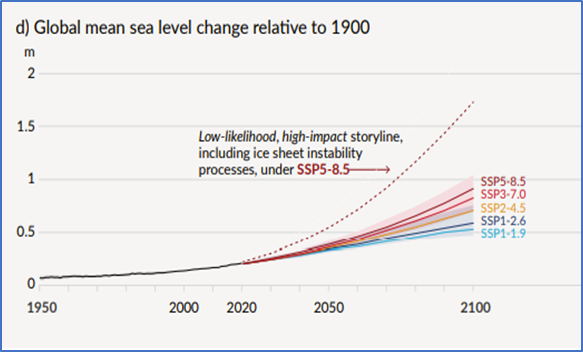The rate of sea-level rise (SLR) has averaged around 3.3 mm per year over the past two decades. But recent evidence shows that the rate increasing as the melting of Arctic and Antarctic ice has accelerated.

Figure 1: Global average sea-level change
The summer minimum extent of Arctic Sea ice has been declining for the past 2 decades, down to a record low of 3.5 million sq. km in 2012. The rate of ice loss in Antarctica has increased more than 6-fold from the 1980s (40Gt/year) to the present decade (252 Gt/year).
The combined ice loss from Antarctica, Greenland, and other glaciers accounts for half of global SLR (1.8 mm/year). The rest is thermal expansion. Other glaciers include the Himalayas, which are also melting at an increasing rate (see Hindu Kush Himalaya Assessment 2019).
Figure 2 shows the projected SLR under the various Shared Socio-economic Pathways prepared for the IPCC AR6.

Figure 2. Global mean sea level change relative to 1900
The most pessimistic (SSP 8.5) suggests an SLR of 1 meter by end of the 21st century, but recent accelerations of melting of several massive Antarctic ice sheets (Pine Island,Thwaites, etc.) and glaciers have forced the introduction of possible SLR of 1.5 meters, or even more.
New maps produced by ClimateCentral (Fig. 3 and 4) give a very disturbing picture of how sea-level rise will impact Bangladesh – from SLR alone and compounded by average annual flooding.
The left map shows the areas in the southwest and the northeast which due to their low elevation would expect to be below the average tideline in 2030, less than a decade from now. The right map shows the areas projected to be inundated by the combination of SLR and average annual flooding by 2030. This is clearly a large proportion of the country, and not only coastal districts but the surrounding Dhaka and Chattogram.

Figure: 3 Figure: 4
It should be noted that these maps do not take account of areas protected by embankments. So, they somewhat overstate the impact, assuming existing embankments continue to perform their protective task.